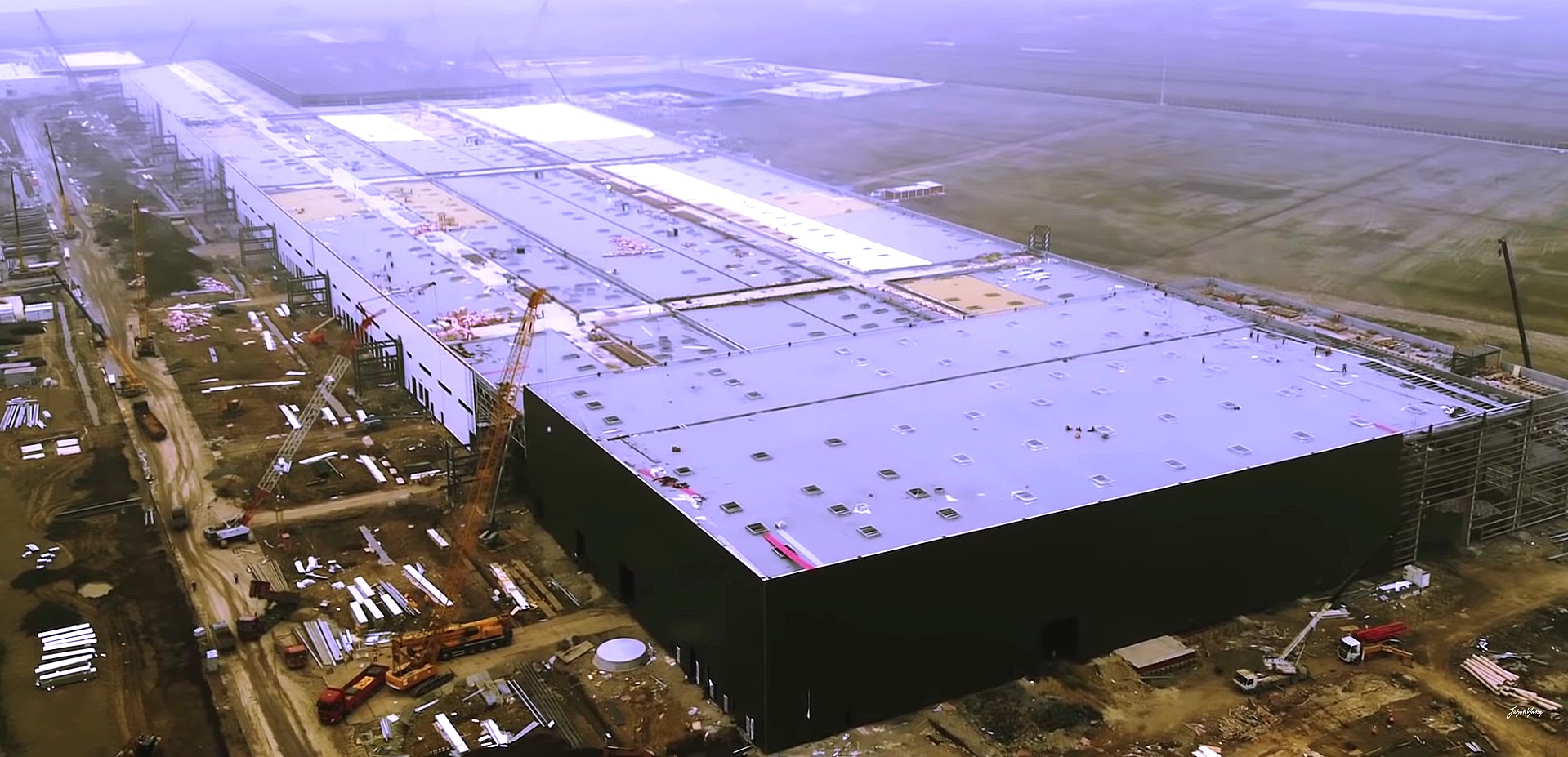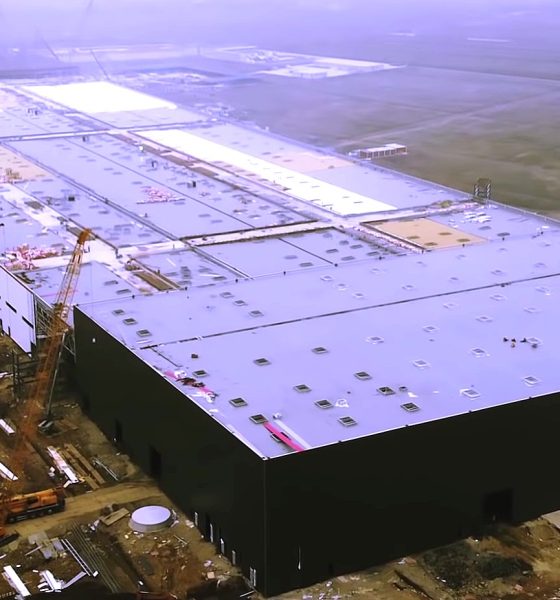

Investor's Corner
Tesla Gigafactory 3’s rise shows that it’s too early to dismiss Elon Musk’s ‘sci-fi projects’
A drone flyover of Gigafactory 3 on Monday has revealed that the factory shell of Tesla’s China-based electric car production facility is all but complete. Only a few small sections of the massive general assembly building do not have roofing yet, and the same is true for Gigafactory 3’s walls. Around the facility’s grounds, workers continued their activities, and cement trucks were seen heading inside the massive factory, hinting at the work being started inside.
Other sections of Tesla’s Gigafactory 3 complex are coming to form as well, including what appears to be dormitories for employees and a possible open-air event staging area. Outside the factory, several large trucks are loaded with massive machinery, seemingly intended for use on the 24/7 construction site. Shanghai officials have noted that Gigafactory 3’s initial construction would be done by May. Considering the progress of the buildout as of Monday, this target appears more than feasible.
The pace of Gigafactory 3’s construction is unprecedented, and it is one that will likely make it to books in the future. China itself, which holds a solid reputation for quick, surgically-precise buildouts, will probably set records with the construction of Gigafactory 3. As Tesla’s electric car factory in Shanghai rises, it is pertinent to note that there was a time, not too long ago, when the idea of Gigafactory 3’s factory shell being completed in roughly five months was considered implausible.
Just over two months ago, Gigafactory 3 was comprised of leveled ground and one steel pillar. A few months before that, it was but a muddy field. Go back a few more months and one will find Elon Musk’s initial announcement for the project’s target timeframe, where the brazen CEO estimated that Tesla would start producing electric cars in the Shanghai facility within two years from construction. During that time, Musk’s two-year timeframe was considered in the United States as “not feasible.” Convention demands car factories to be built over years, after all.
Yet here it stands now, tangible, and ahead of Elon Musk’s own target schedule. After Gigafactory 3’s shell is completed this May, the facility is set to undergo ground hardening in June. These will be followed by pipeline communication, equipment stationing, equipment commissioning, and trial production runs, which could start as early as September barring any unexpected issues. This means that by the end of the year, Gigafactory 3 might already hit some of its stride in the production of Tesla’s midsize electric sedan.
Tesla is simply not a conventional company, and neither is its projects. It’s a disruptor that has reached a critical mass — no longer small enough to be ignored, but not yet large enough to warrant unquestionable respect. This, together with Elon Musk’s persona, both in real life and online, has brought a lot of attention to Tesla. Unfortunately, most of this attention today are predominantly negative, as could be seen in the overarching narrative surrounding the company. An example of this could be seen in a recent note published by Wedbush analyst Dan Ives, where he criticized Tesla and Elon Musk for pursuing “sci-fi” projects like Full Self-Driving, an in-house insurance service, and a Robotaxi network.
Elon Musk is an optimist, and this shows when he announced target timeframes for projects like the Model 3 ramp or the release of features such as Advanced Summon. Nevertheless, Elon Musk might tend to overpromise and deliver late; but his ideas, his visions, are not implausible. They might sound like ideas that are straight out of science fiction, but he, Tesla, SpaceX, and his other ventures are hard at work making that science fiction a reality. There was a time, after all, where people thought replacing the yellow pages, or managing their money through the internet, or landing rockets on a drone ship, was an insane idea. And yet here we are.
Here’s Tesla’s Gigafactory 3 site as of Monday, May 20, 2019.
And here’s the site back in late January.

Investor's Corner
Tesla stock closes at all-time high on heels of Robotaxi progress

Tesla stock (NASDAQ: TSLA) closed at an all-time high on Tuesday, jumping over 3 percent during the day and finishing at $489.88.
The price beats the previous record close, which was $479.86.
Shares have had a crazy year, dipping more than 40 percent from the start of the year. The stock then started to recover once again around late April, when its price started to climb back up from the low $200 level.
This week, Tesla started to climb toward its highest levels ever, as it was revealed on Sunday that the company was testing driverless Robotaxis in Austin. The spike in value pushed the company’s valuation to $1.63 trillion.
Tesla Robotaxi goes driverless as Musk confirms Safety Monitor removal testing
It is the seventh-most valuable company on the market currently, trailing Nvidia, Apple, Alphabet (Google), Microsoft, Amazon, and Meta.
Shares closed up $14.57 today, up over 3 percent.
The stock has gone through a lot this year, as previously mentioned. Shares tumbled in Q1 due to CEO Elon Musk’s involvement with the Department of Government Efficiency (DOGE), which pulled his attention away from his companies and left a major overhang on their valuations.
However, things started to rebound halfway through the year, and as the government started to phase out the $7,500 tax credit, demand spiked as consumers tried to take advantage of it.
Q3 deliveries were the highest in company history, and Tesla responded to the loss of the tax credit with the launch of the Model 3 and Model Y Standard.
Additionally, analysts have announced high expectations this week for the company on Wall Street as Robotaxi continues to be the focus. With autonomy within Tesla’s sights, things are moving in the direction of Robotaxi being a major catalyst for growth on the Street in the coming year.
Elon Musk
Tesla needs to come through on this one Robotaxi metric, analyst says
“We think the key focus from here will be how fast Tesla can scale driverless operations (including if Tesla’s approach to software/hardware allows it to scale significantly faster than competitors, as the company has argued), and on profitability.”

Tesla needs to come through on this one Robotaxi metric, Mark Delaney of Goldman Sachs says.
Tesla is in the process of rolling out its Robotaxi platform to areas outside of Austin and the California Bay Area. It has plans to launch in five additional cities, including Houston, Dallas, Miami, Las Vegas, and Phoenix.
However, the company’s expansion is not what the focus needs to be, according to Delaney. It’s the speed of deployment.
The analyst said:
“We think the key focus from here will be how fast Tesla can scale driverless operations (including if Tesla’s approach to software/hardware allows it to scale significantly faster than competitors, as the company has argued), and on profitability.”
Profitability will come as the Robotaxi fleet expands. Making that money will be dependent on when Tesla can initiate rides in more areas, giving more customers access to the program.
There are some additional things that the company needs to make happen ahead of the major Robotaxi expansion, one of those things is launching driverless rides in Austin, the first city in which it launched the program.
This week, Tesla started testing driverless Robotaxi rides in Austin, as two different Model Y units were spotted with no occupants, a huge step in the company’s plans for the ride-sharing platform.
Tesla Robotaxi goes driverless as Musk confirms Safety Monitor removal testing
CEO Elon Musk has been hoping to remove Safety Monitors from Robotaxis in Austin for several months, first mentioning the plan to have them out by the end of 2025 in September. He confirmed on Sunday that Tesla had officially removed vehicle occupants and started testing truly unsupervised rides.
Although Safety Monitors in Austin have been sitting in the passenger’s seat, they have still had the ability to override things in case of an emergency. After all, the ultimate goal was safety and avoiding any accidents or injuries.
Goldman Sachs reiterated its ‘Neutral’ rating and its $400 price target. Delaney said, “Tesla is making progress with its autonomous technology,” and recent developments make it evident that this is true.
Investor's Corner
Tesla gets bold Robotaxi prediction from Wall Street firm
Last week, Andrew Percoco took over Tesla analysis for Morgan Stanley from Adam Jonas, who covered the stock for years. Percoco seems to be less optimistic and bullish on Tesla shares, while still being fair and balanced in his analysis.

Tesla (NASDAQ: TSLA) received a bold Robotaxi prediction from Morgan Stanley, which anticipates a dramatic increase in the size of the company’s autonomous ride-hailing suite in the coming years.
Last week, Andrew Percoco took over Tesla analysis for Morgan Stanley from Adam Jonas, who covered the stock for years. Percoco seems to be less optimistic and bullish on Tesla shares, while still being fair and balanced in his analysis.
Percoco dug into the Robotaxi fleet and its expansion in the coming years in his latest note, released on Tuesday. The firm expects Tesla to increase the Robotaxi fleet size to 1,000 vehicles in 2026. However, that’s small-scale compared to what they expect from Tesla in a decade.
Tesla expands Robotaxi app access once again, this time on a global scale
By 2035, Morgan Stanley believes there will be one million Robotaxis on the road across multiple cities, a major jump and a considerable fleet size. We assume this means the fleet of vehicles Tesla will operate internally, and not including passenger-owned vehicles that could be added through software updates.
He also listed three specific catalysts that investors should pay attention to, as these will represent the company being on track to achieve its Robotaxi dreams:
- Opening Robotaxi to the public without a Safety Monitor. Timing is unclear, but it appears that Tesla is getting closer by the day.
- Improvement in safety metrics without the Safety Monitor. Tesla’s ability to improve its safety metrics as it scales miles driven without the Safety Monitor is imperative as it looks to scale in new states and cities in 2026.
- Cybercab start of production, targeted for April 2026. Tesla’s Cybercab is a purpose-built vehicle (no steering wheel or pedals, only two seats) that is expected to be produced through its state-of-the-art unboxed manufacturing process, offering further cost reductions and thus accelerating adoption over time.
Robotaxi stands to be one of Tesla’s most significant revenue contributors, especially as the company plans to continue expanding its ride-hailing service across the world in the coming years.
Its current deployment strategy is controlled and conservative to avoid any drastic and potentially program-ruining incidents.
So far, the program, which is active in Austin and the California Bay Area, has been widely successful.








